Connect to a Tableau Site
Learning Objectives
After completing this unit, you’ll be able to:
- Sign in to a Tableau Cloud site.
- Explore and navigate a Tableau Cloud site.
Sites are used in Tableau as independent entities for different organizations or groups on a single server system. Sites can be used to isolate workbooks, data, and users from other sites. If you are a member of multiple sites, you are prompted to select a site when you log in to Tableau Server or Tableau Cloud.
Imagine that the data steward in your company has already published the data source and some views to the company Tableau site. To interact with this data and create your own views, you need to sign into the Tableau site.
In this module, we show you the steps to sign in to Tableau Cloud, connect to a data source, and prepare your data for analysis. If you don't have access to Tableau Cloud or the Explorer (can publish) permission, that’s OK. Read along to learn how you would take the steps in Tableau Cloud. In the next unit, you'll try out some steps in our simulator. Don't try to follow these steps in your Trailhead Playground. Tableau Cloud isn't available in the Trailhead Playground.
Sign In to Tableau Cloud
To sign in to Tableau Cloud, you use a Tableau account. Your site administrator will invite you to join a Tableau Cloud site; you then create a Tableau Cloud account and sign in to the site.
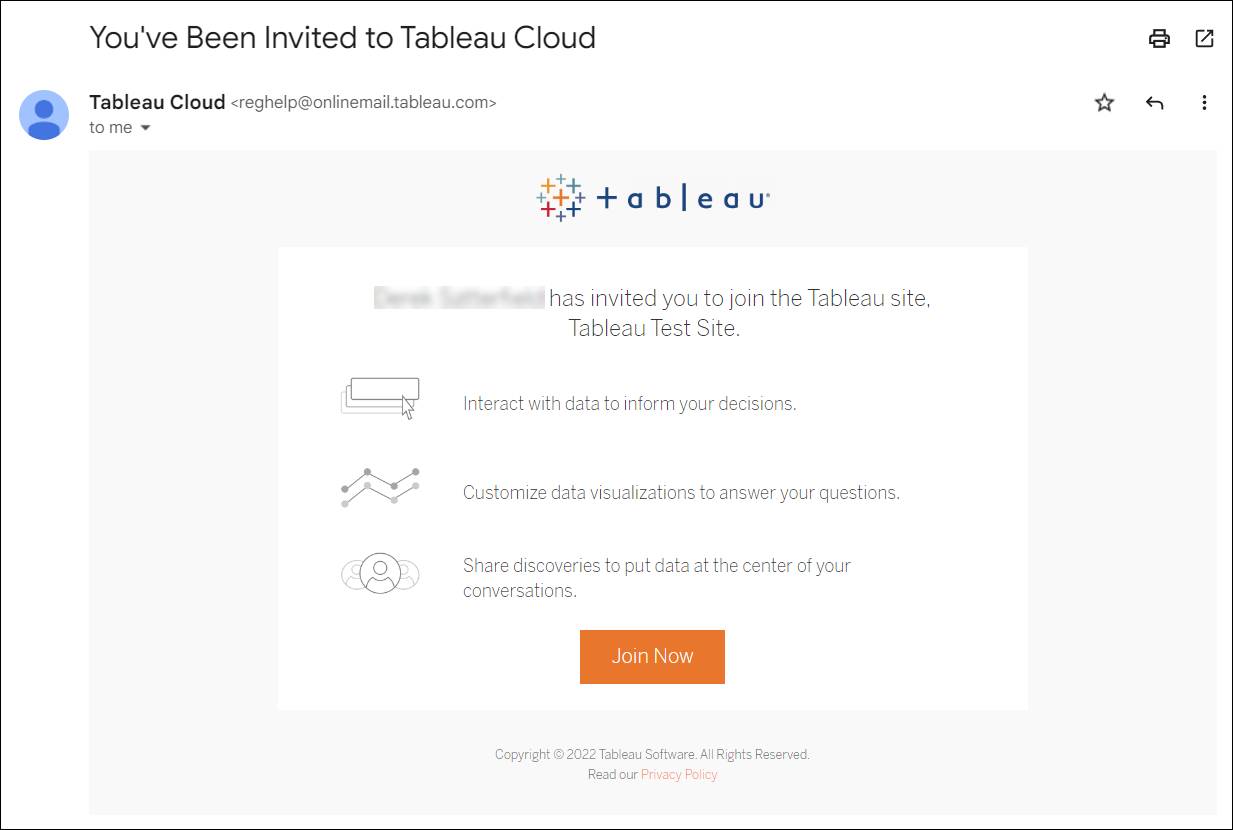
Create Your Tableau Account
If you don’t already have one, you need to create your Tableau account.
- In the email message sent by the site administrator, click Join Now.
- Enter your First and Last name.
- Create and confirm a password for the account.
- Click Let's Go to create your account.
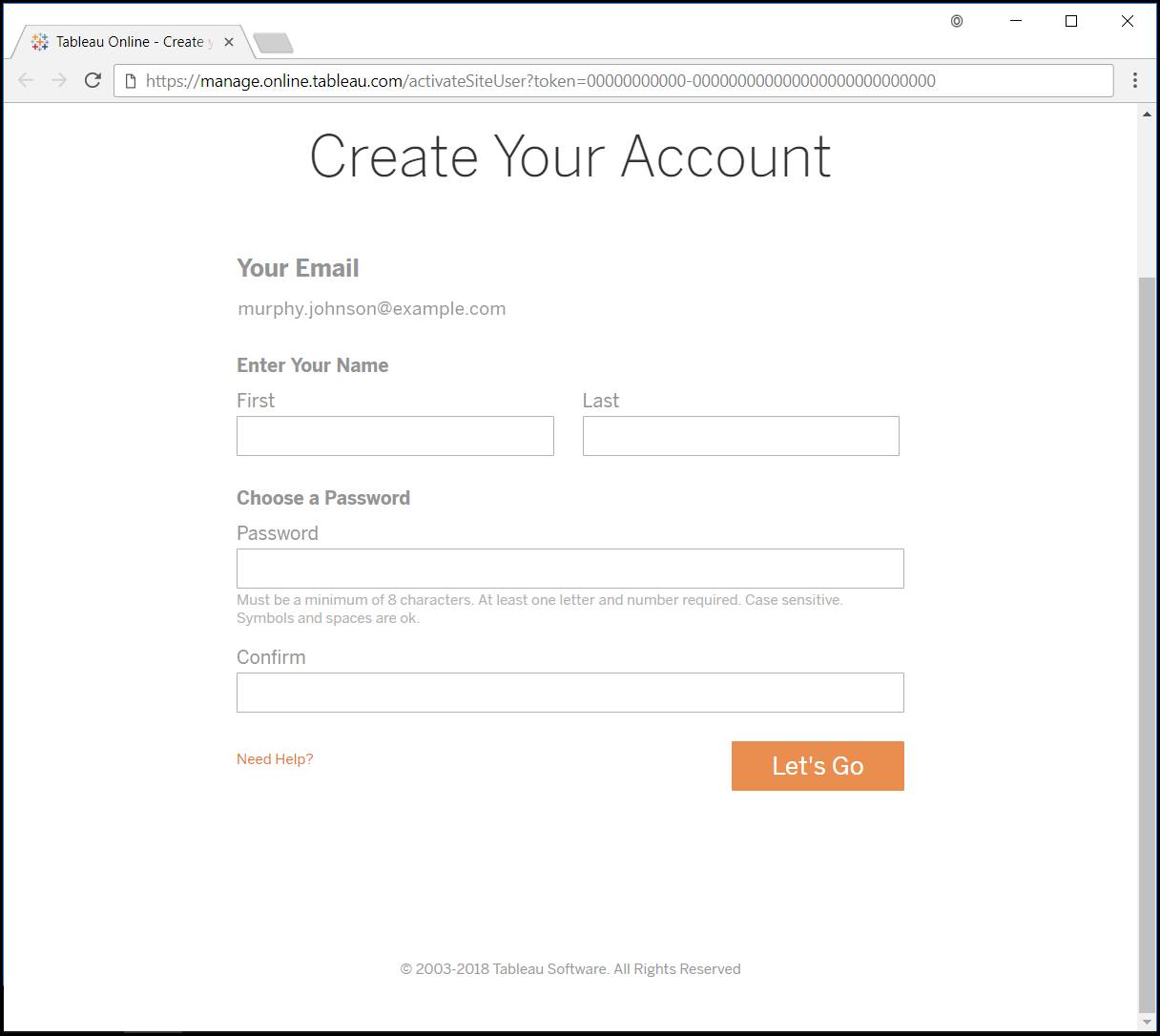
Sign In to a Tableau Cloud Site
Next, you need to sign in to a Tableau Cloud site.
- Go to https://online.tableau.com.
- Enter the email address used to create your Tableau Cloud account (the same email address your invitation was sent to).
- Click Sign In.

- Enter the password for your Tableau Cloud account. (This is the password you used to create the account, not necessarily your email password.)
- Click Sign In again.
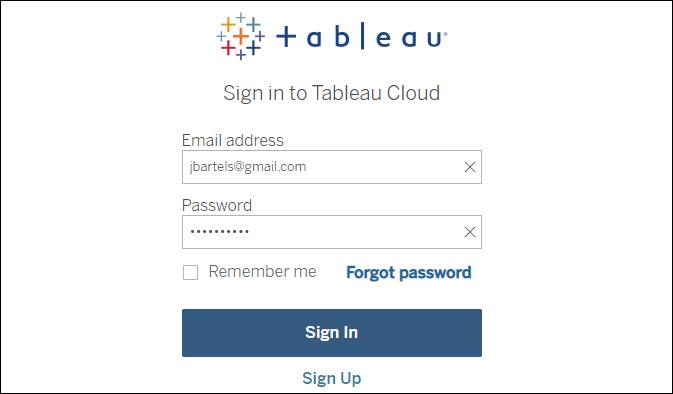
- Verify your identity by entering the code generated by your authenticator app. For more information, see the Help article on Multi-Factor Authentication.
- Click Verify.
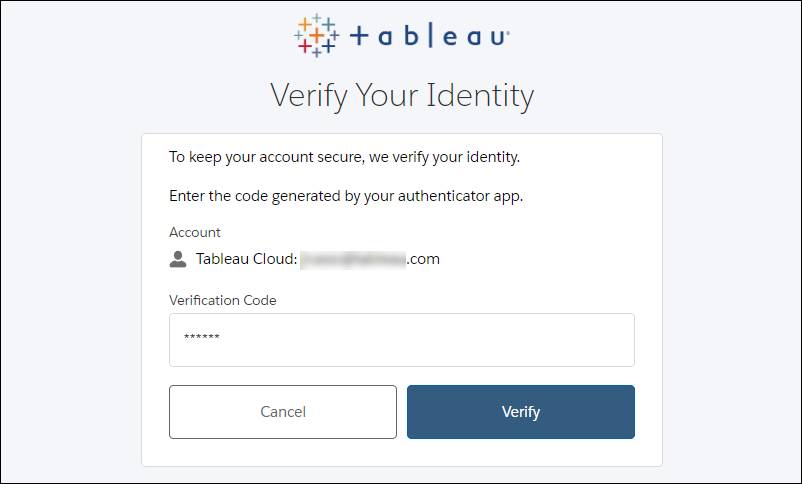
- If you have multiple Tableau Cloud sites associated with your email address, you need to select a site.
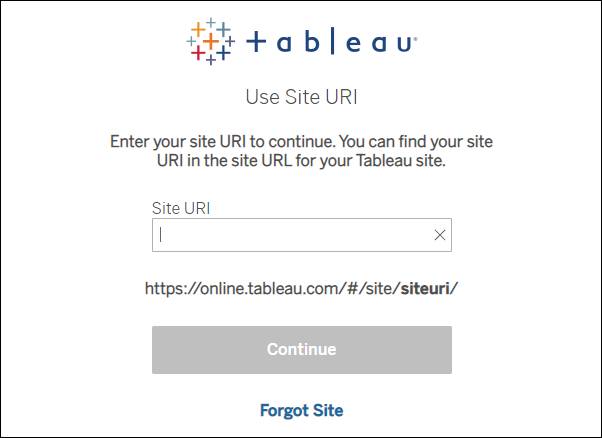
Explore and Find Content on a Tableau Site
Now that you are signed in to your Tableau site, let’s see what kind of content is available.
The first page you see is the Home page. The Home page gives you quick access to newly added favorites, recently visited views, and popular content.
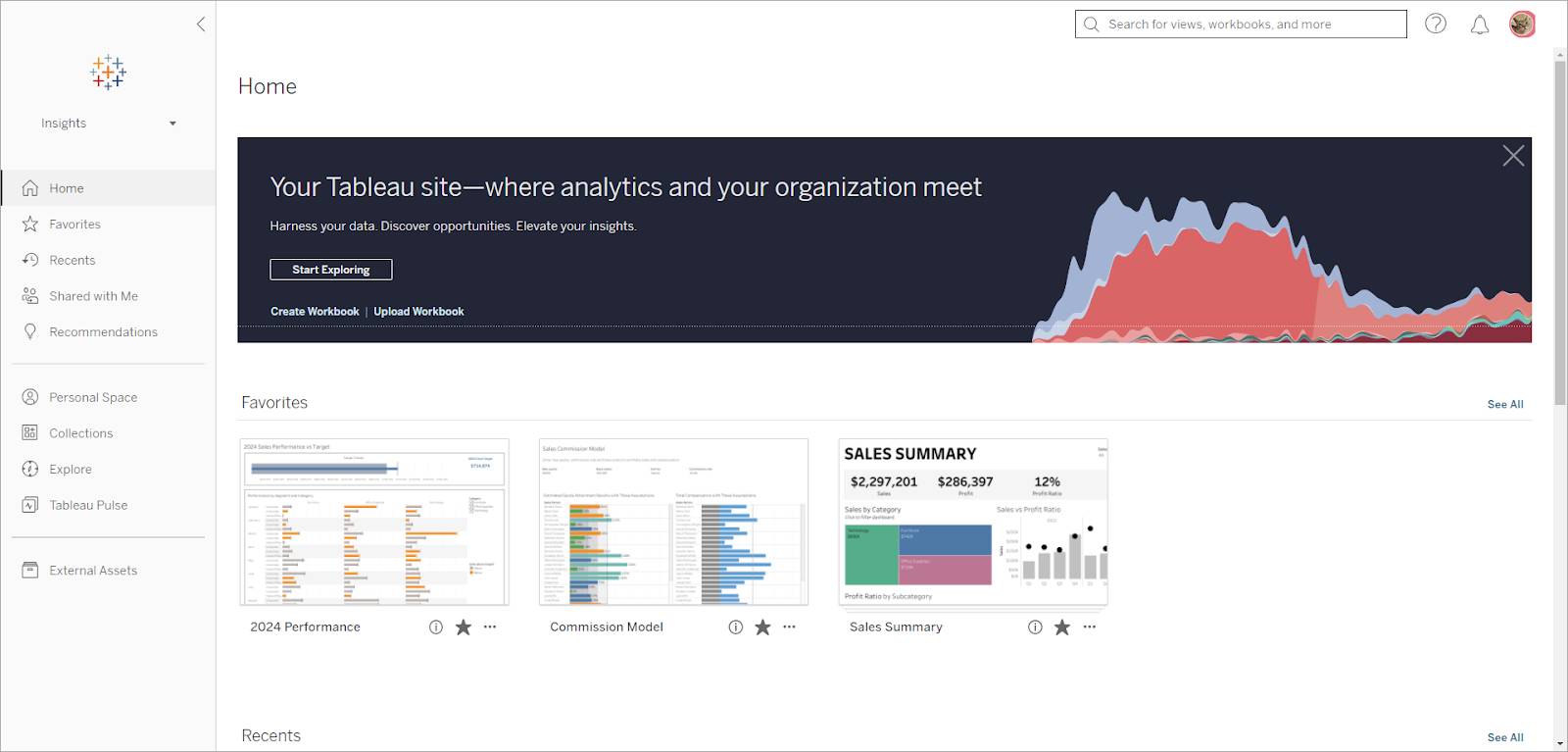
The navigation side bar on the left also offers quick access to these pages.
-
Favorites: All the content you’ve added to your Favorites.
-
Recents: Recently viewed content.
-
Shared with Me: Content that others have shared with you.
-
Recommendations: Personalized suggestions based on relevance.
-
Personal Space: A place to connect to data and publish it so only you can access it. It’s not possible to share content saved in Personal Space with other users, but you can move that content to a project when you’re ready for others to see it.
-
Collections: Content you have organized in a meaningful way for you (similar to a “playlist” one might use with a media application).
-
Explore: A location where you can explore content (workbooks, views, data sources, and so on) across the site.
-
Tableau Pulse: Navigates to Tableau Pulse (Tableau Cloud only)
-
External Assets: See tables, databases, and files (requires Tableau Catalog, part of the separately licensed Data Management add-on)
Let’s look at the Explore page in more detail.
To see all of the content you have access to, select Explore from the navigation pane. Your site role and permissions determine the content and options that you can see.
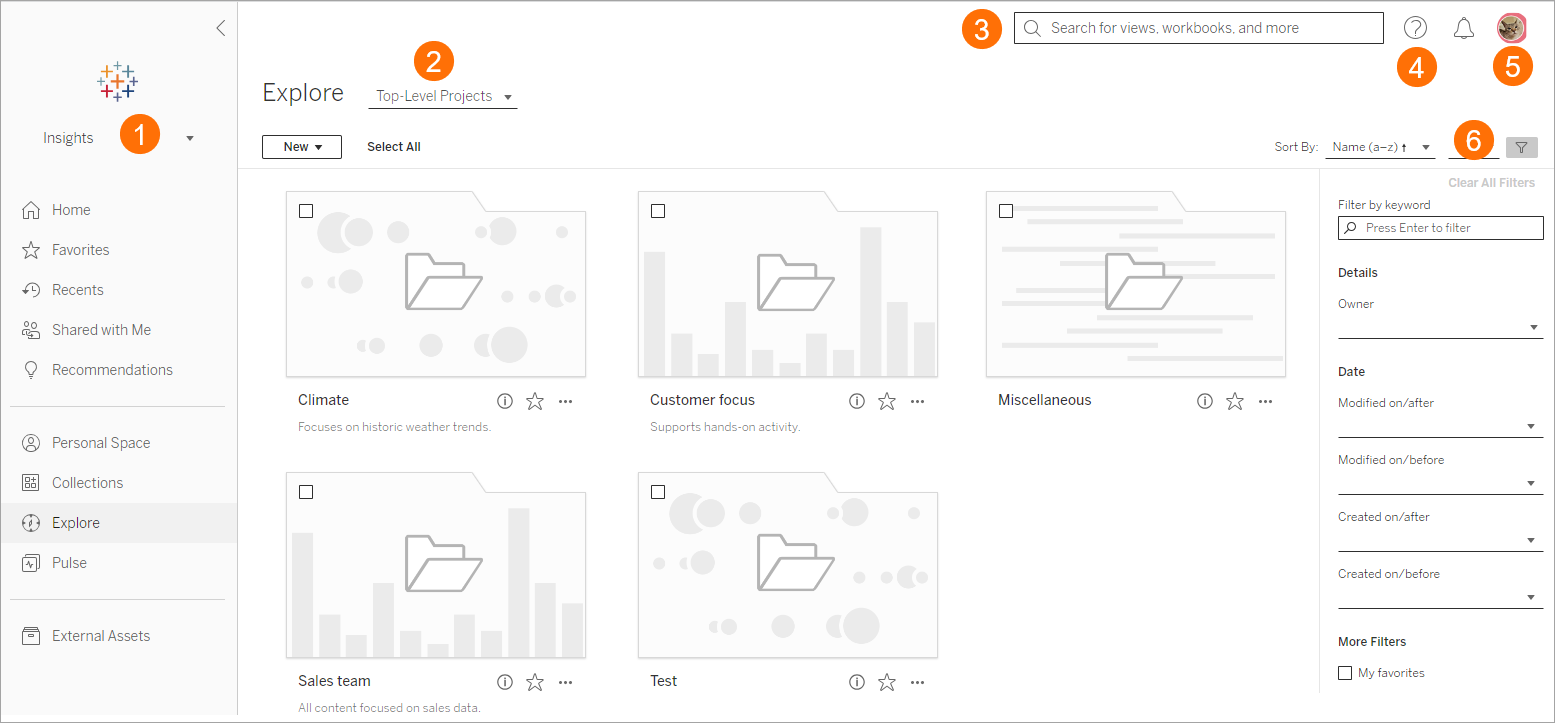
The Explore page has a number of features to help you find the content you need.
-
Site picker (available if you have access to more than one site): Use the dropdown arrow to switch between sites.
-
Content type menu: Navigate to the content on the site, such as all projects, views, or data sources.
-
Quick search: Use keywords to quickly search for a view or a project.
-
Help menu: Access Tableau Cloud Help and other resources.
-
Your content and settings: Access your personal space, content, account settings (such as your site role), designate your start page, and sign out of the site.
-
Filtered search: Search for content on the site using various filters.
Content Types on a Tableau Site
Use the content type menu to select different content types.
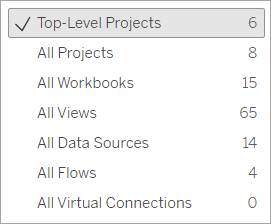
Some of the most common content types include:
Projects
Projects are essentially folders that organize the content on your site. Top-level projects can contain other (nested) projects, forming a hierarchy that you navigate like the file system on your computer. When you open a project, you see all of the content that the project contains on a single page, including any nested projects, workbooks, data sources, and so forth.
Workbooks
Workbooks are packages of views. A workbook page shows the views included in the workbook and the data sources used by the workbook. It also provides a list of user subscriptions to either the workbook or to individual views.
Views
A view is a single worksheet, dashboard, or story contained in a workbook. A view page displays options for interacting with the view, including sharing, subscribing, and editing.
Data Sources
A data source page shows connections to databases or file-based data, as well as the workbooks connected to the data source. If the data source is an extract, the page shows scheduled extract refreshes.
Flows
On a Tableau Prep flow page, you can see the structure of a flow, the data sources connected to it, as well as its run history, lineage, and any subscriptions to the flow. From this page, users with Creator site roles can run the flows they authored or, with Tableau Prep Conductor (part of the Data Management Add-on), they can set a schedule to run flows they authored.
Virtual Connections
See virtual connections that have been configured and published (examples include Google BigQuery, PostgreSQL, and Salesforce).
Watch the video to learn how to find and navigate to content a Tableau Cloud site.
Now that you’re signed in to a Tableau Cloud site, let’s connect to your data.
Resource